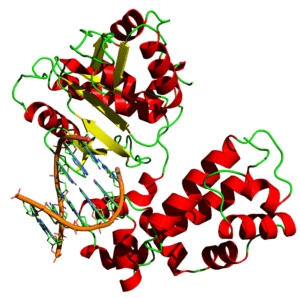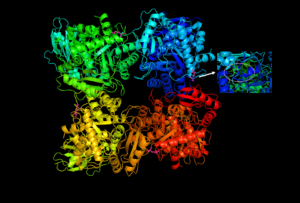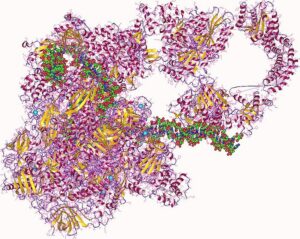Anabolism refers to a group of metabolic mechanisms that build compounds from smaller components.There is a detailed description of anabolic enzyme example provided.
Anabolic enzymes facilitate metabolic events involving the construction of bigger complex compounds from simpler ones. These anabolic reactions need a significant amount of energy. Endergonic processes are another name for them.
- DNA polymerase.
- ATP synthase
- Ribulose-1,5-bisphosphate carboxylase-oxygenase,
- Glycogen synthase.
- Glycogen synthase kinase 3
- Glucokinase
- Hexokinases
- Phosphoglucomutase
- RNA polymerase
- Glutamine synthetase
- Methionine synthase
- Asparagine synthetase
- Aminoacyl-tRNA-synthetase
- Glycosyltransferase
- DNA ligase
- Citrate synthase
- Pseudouridine synthase
- Fatty acid synthase
- Cellulose synthase
- Succinyl coenzyme A synthetase
- Anabolic Ornithine Carbamoyltransferase
DNA polymerase
DNA polymerase is a well-known example of an anabolic enzyme. The DNA molecule is rebuilt by this enzyme. DNA polymerase assembles nucleotides to form DNA molecules.

DNA’s building units are nucleotides. It is required for DNA replication, and it usually works in pairs to produce two identical DNA strands from a single DNA molecule (template).
ATP synthase
The ATP synthase is a mitochondrial enzyme that catalyzes the synthesis of ATP from ADP and phosphate. It is driven by a flux of protons over a gradient created by electron transfer from the proton’s chemically positive to negative side.
Ribulose-1,5-bisphosphate carboxylase-oxygenase,
The enzyme ribulose-1,5-bisphosphate carboxylase-oxygenase (RuBisCo) is engaged in the first major phase of carbon fixation, which is the conversion of atmospheric carbon dioxide to energy-rich compounds like glucose by plants and other photosynthetic organisms.

RubisCO is essential for the survival of life on Earth because it catalyzes the conversion of atmospheric CO(2) to organic matter.
Glycogen synthase
Glycogen synthase (UDP-glucose-glycogen glucosyltransferase) is a crucial enzyme in glycogenesis, the process of converting glucose to glycogen. Glycogen synthase (GS) is a skeletal muscle enzyme that catalyzes the conversion of uridine diphosphate-glucose to glycogen. GS activity is assumed to be rate-limiting in the disposal of glucose as muscle glycogen in conjunction with the glucose transport stage.
Glycogen synthase kinase 3
Glycogen synthase kinase 3 (GSK-3) is a serine/threonine protein kinase that allows phosphate molecules to be added to serine and threonine amino acid residues.
Glucokinase
The enzyme glucosekinase aids in the phosphorylation of glucose to glucose-6-phosphate. Humans and most other animals have glucokinase in their liver and pancreas cells. It acts as a glucose sensor in each of these organs, causing changes in metabolism or cell function in response to changes in glucose levels.
Hexokinases
Hexokinase is a phosphorylating enzyme that converts hexoses (six-carbon sugars) to hexose phosphate.Hexokinase can take an inorganic phosphate group from ATP and transfer it to a substrate.
Phosphoglucomutase
Phosphoglucomutase is an enzyme that moves a phosphate group from the 1 to the 6 position on a -D-glucose monomer in one direction or from the 6 to the 1 position in the other.
RNA polymerase
RNA polymerase (green) follows a strand of DNA to make RNA.

The enzyme RNA polymerase is responsible for transcribing a DNA sequence into an RNA sequence during the transcription process.
Glutamine synthetase
Glutamine synthetase is an enzyme that catalyses the condensation of glutamate and ammonia to create glutamine, which is an important step in nitrogen metabolism.
Methionine synthase
The enzyme aids in the digestion of amino acids, which are the building blocks of proteins. Methionine synthase, in particular, performs a chemical reaction that transforms the amino acid homocysteine to the amino acid methionine. Methionine is used by the body to create proteins and other essential chemicals.
Asparagine synthetase
Asparagine Synthetase is a cytoplasmic enzyme that catalyses the ATP-dependent amidotransferase process that produces the non-essential amino acid asparagine from aspartate and glutamine.
Aminoacyl-tRNA-synthetase
The enzyme aminoacyl-tRNA synthetase (aaRS or ARS), also known as tRNA-ligase, binds the proper amino acid to its associated tRNA. It accomplishes this by catalysing the transesterification of a cognate amino acid or its precursor to one of the cognate tRNAs that are compatible with it, resulting in an aminoacyl-tRNA. Twenty separate aminoacyl-tRNA synthetases, one for each amino acid in the genetic code, produce the 20 different forms of aa-tRNA in humans.
Glycosyltransferase
Glycosyltransferases are enzymes that initiate and lengthen glycan chains on mucins by transferring active sugar residues to the correct acceptor.
DNA ligase
DNA ligase is a type of ligase that catalyses the formation of a phosphodiester bond between DNA strands, making it easier to bind them together. In living creatures, it helps to repair single-strand breaks in duplex DNA, although some forms may also help to repair double-strand breaks.
Citrate synthase
Citrate synthase is a pace-making enzyme in the first step of the citric acid cycle that is found in practically all living cells (or Krebs cycle).

Citrate synthase is found in the mitochondrial matrix of eukaryotic cells, however it is encoded by nuclear DNA rather than mitochondrial DNA. It is produced in the cytoplasm and subsequently transferred to the mitochondrial matrix.
Pseudouridine synthase
Pseudouridine synthases are the enzymes responsible for the majority of biological RNA posttranslational modifications. These enzymes appear to use both sequence and structural information to achieve site specificity in the isomerization of uridine residues that are already part of an RNA chain.
Fatty acid synthase
Fatty acid synthase, which catalyses the formation of long-chain fatty acids from acetyl-CoA and malonyl-CoAAs, is the rate-limiting enzyme in the fatty acid synthesis pathway.
Cellulose synthase
Cellulose synthase is a huge protein complex that builds cellulose strands and fibrils in the plant plasma membrane. The complex is a huge rosette with about 6-fold symmetry, made up of six trimers containing three slightly different enzyme types.To make cellulose, cellulose synthase employs an active form of glucose linked to a UDP nucleotide.
Succinyl coenzyme A synthetase
Succinyl coenzyme A synthetase catalyses the reversible conversion of succinyl-CoA to succinate. The enzyme aids in the creation of a nucleoside triphosphate molecule (GTP or ATP) from an inorganic phosphate molecule and a nucleoside diphosphate molecule from this process (either GDP or ADP). It is found within the mitochondrial matrix of a cell and serves as one of the catalysts in the citric acid cycle, which is a critical step in cellular metabolism.
Anabolic Ornithine Carbamoyltransferase
Ornithine transcarbamylase (OTC) (also known as ornithine carbamoyltransferase) is an enzyme that catalyses the conversion of carbamoyl phosphate (CP) to citrulline (Cit) and phosphate (Pi).In prokaryotes, anabolic OTC aids the sixth step in the production of the amino acid arginine. [5] Mammalian OTC, on the other hand, is critical to the urea cycle, which captures poisonous ammonia and converts it to urea, a less toxic nitrogen source, for excretion.
Also Read:
- Plant cell structure
- Do animal cells have chloroplasts
- Are globular proteins soluble
- Example of eukaryotic cell
- Centipede characteristics
- Arachnid characteristics
- Why chromosomes are in pairs
- Do protists move
- Are algae multicellular
- Digestive enzymes in lysosomes

Hi…I am Sadiqua Noor, done Postgraduation in Biotechnology, my area of interest is molecular biology and genetics, apart from these I have a keen interest in scientific article writing in simpler words so that the people from non-science backgrounds can also understand the beauty and gifts of science. I have 5 years of experience as a tutor.
Let’s connect through LinkedIn-